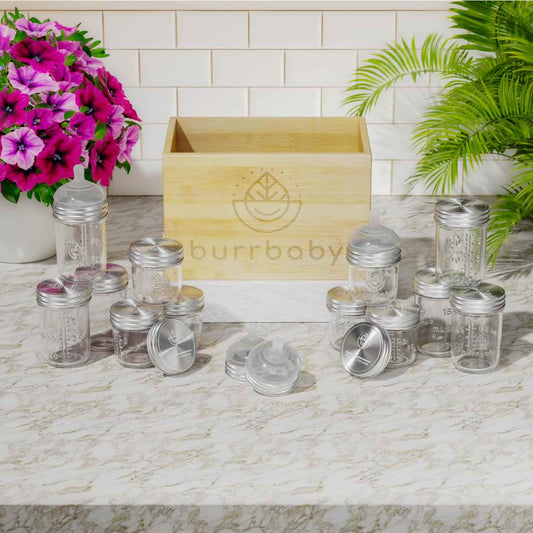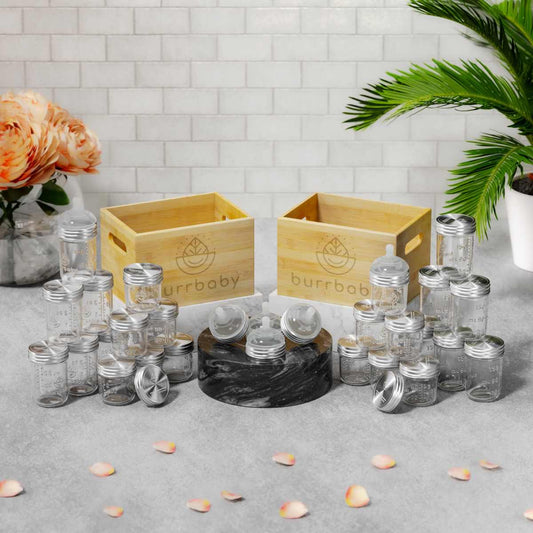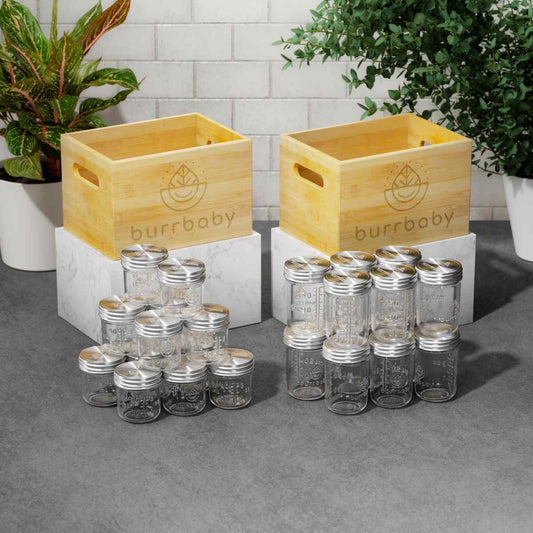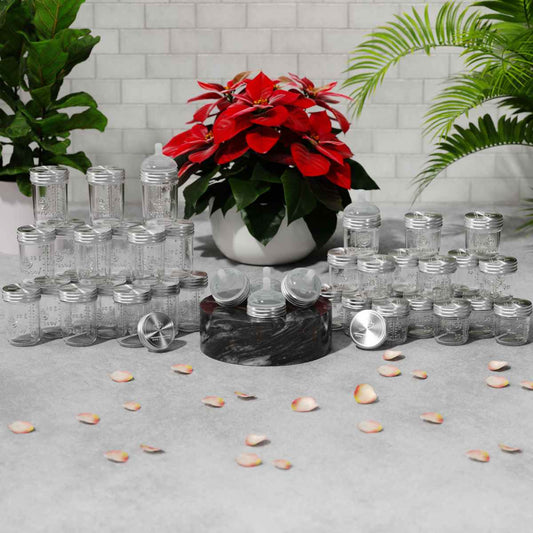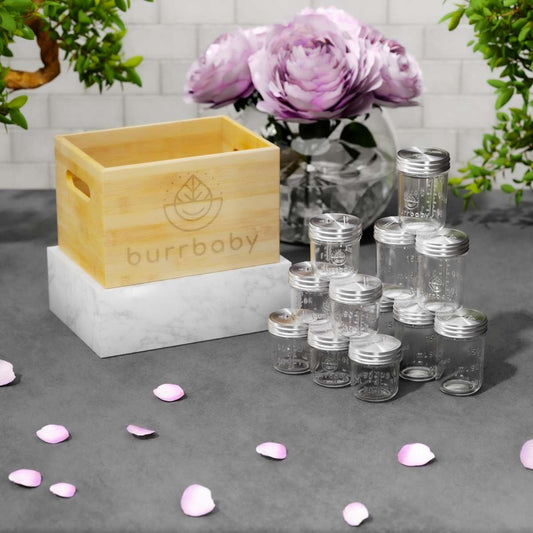You go through a lot of work pumping your breast milk, so the last thing you want is for it to go bad quicker or be unsafe for your baby because your breast milk storage bottles weren't clean and sanitary. With thorough cleaning, you can prevent the growth of harmful bacteria that could jeopardize the quality and safety of your breast milk.
Article Overview
- Intro to Glass Containers
- Preparing New Glass Containers for First Use
- Keeping Your Glass Breast Milk Storage Containers Clean
- Sterilization Recommendations For Glass Breast Milk Containers
- Tips for Handling Glass Breast Milk Containers
- Temperature Guidelines for Breast Milk Storage
- Labeling and Organizing Containers
At Burrbaby, we're dedicated to being a part of a healthier world for your children. We hope to accomplish this through our zero-plastic glass breast milk storage containers and bottles. These completely non-toxic, sustainable choices protect your baby's health and our planet.
Intro to Glass Containers: A Safe Alternative to Plastic
Before we start, you might be wondering why you would choose glass over plastic or silicone. There are many advantages to glass storage containers and bottles for breastmilk.
By picking glass, your baby will be safe from potential exposure to chemicals found in plastic containers along with microplastic particles that can shed into breast milk. Glass allows for a healthier and safer environment for your baby while promoting eco-friendly practices in your home.
Preparing New Glass Containers for First Use
Before using your new glass breast milk containers for the first time, cleaning them to ensures they are free from any contaminants from manufacturing and shipping. Start by carefully removing labels or stickers attached to the containers.

Next, immerse the containers and deconstructed parts in warm, soapy water and scrub the entire surface of the glass and accessories with a soft brush or sponge. Finally, rinse under warm running water to eliminate any remaining soap residue.
When it comes to soap, try to use natural soap with as few synthetic chemicals and fragrances as possible. Although you're rinsing all the soap off, it still gives peace of mind knowing if there is any residue left, it isn't going to cause harm to your baby. In addition to your baby's health, using natural dish soap minimizes damage to your skin and the environment as well.
Step-by-Step Guide: Keeping Your Glass Breast Milk Storage Containers Clean
- Begin with clean hands: Wash your hands thoroughly with soap and water to ensure optimal hygiene and give yourself a good start to cleaning the glass containers.
- Disassemble the parts: Separate all bottle parts (e.g., bottles, nipples, caps, rings, valves) for comprehensive cleaning. For Burrbaby's glass breast milk storage containers, this is easy. simply take off the stainless steel lid and separate the silicon seal. For Burrbaby bottles, just separate the ring from the nipple.
- Initial rinse: Rinse the containers and parts with warm water to remove residual milk, preventing it from hardening and making cleaning more difficult.
- Soak and scrub: Submerge the container and parts in warm, soapy water (preferably natural dish soap). Gently scrub using a soft brush or sponge to eliminate any lingering traces of milk. Use an appropriately sized brush to access hard-to-reach areas, such as the bottle's neck and base. If you aren't quite ready to do a full clean, you can leave the parts in the water tub until you are ready.
- Thorough rinsing: Meticulously rinse the containers and parts under running water to remove any soap remnants.
- Towel dry and air dry: Wipe the washed breast milk storage jar and bottle parts with a clean dry towel, and place them on a drying rack to further dry any water you might have missed. If you have to go straight from towel drying to air drying, that's ok too! Just avoid going from towel drying to putting all the pieces back together unless absolutely necessary to promote complete drying. Although glass and stainless steel are much more resistant to bacterial growth than plastic, residual water still isn't our friend.
- Clean the wash basin and bottle brush: Rinse the wash basin and brush well and allow them to air-dry after each use if possible.
This step-by-step guide to washing breast milk storage jars and glass baby bottles will help you maintain optimal hygiene for your glass breast milk storage, ensuring you provide your baby a safe and healthy feeding experience.
Sterilization Recommendations For Glass Breast Milk Containers
Sterilizing your glass breast milk storage containers can further help eliminate bacteria and ensure the utmost safety for your baby. Various sterilization methods can be employed, each with its own merits. However, the most common recommendation is electric steam sterilization after cleaning.
- Boiling Method: Submerge the disassembled containers in water and bring them to a boil. Boil the containers for at least five minutes before carefully removing them with tongs, allowing them to cool and air dry on a clean surface. For silicone parts, boiling can be more harsh than other methods.
- Steam Sterilization Method: Use a specialized electric steam sterilizer or a microwave steam sterilizer to sanitize your containers according to the manufacturer's instructions. Sterilization is a great way to kill bacteria while not being detrimental to the part components.
- Microwave Sterilization Bags: Place the disassembled containers in a microwave-safe sterilization bag and follow the bag's instructions to sterilize the containers effectively.
Tips for Handling Glass Breast Milk Containers
Glass storage containers offer a myriad of advantages, from eco-friendliness to preserving the quality of stored breast milk and keeping your baby safe. However, since they can be more fragile than their plastic alternatives, you should be a bit more careful when handling them.

Use Caution When Handling
To prevent accidents, always handle glass containers with a bit more care than you would plastic. Avoid using excessive force when opening or closing lids, leading to breakage or compromised sealing. That said, high-quality glass containers like the ones offered by Burrbaby are quite strong.
Have a Designated Storage Area
You can reduce the likelihood of accidental damage by designating a specific area for storing glass containers. Burrbaby's bamboo storage box (found in many storage and feeding bundles), for example, adds a touch of elegance and provides a safe and organized storage solution. Ensure the box is secure, stable, and away from potential hazards or high-traffic areas.
Temperature Guidelines for Breast Milk Storage
To preserve the nutritional quality of breast milk, it is crucial to adhere to proper storage guidelines, including refrigeration and freezing.
Refrigerator Storage of Breast Milk
When storing breast milk in the refrigerator, place the glass containers in the back, where the temperature is most consistent. Avoid storing them in the door, as temperature fluctuations from opening can compromise milk quality. Refrigerated breast milk should be used within four days.
Freezer Storage of Breast Milk
For longer-term storage, glass containers can be safely stored in the freezer. Ensure the containers aren't filled too high with sufficient room for expansion, and keep them away from the freezer door to avoid temperature fluctuations if possible. Frozen breast milk can be stored for up to six months in a standard freezer and up to 12 months in a deep freezer.
Thawing and Warming Breast Milk
Thaw the stored breast milk in the refrigerator or by placing the glass container in a bowl of warm water. Avoid microwaving or submerging in boiling water, which can create hot spots and compromise the milk's nutritional content.
Read more about tips for safe freezer and refrigerator storage for breast milk.
Labeling and Organizing Containers
Proper labeling and organization can help you efficiently store and use your breast milk.

Date and Volume Labeling
Label each container with the date and volume of your milk was expressed to ensure timely usage and adherence to the first-in, first-out (FIFO) system. This will prevent spoilage and ensure the baby receives the freshest milk possible.
First in, first out simply means you are making sure to use the older milk before newer milk, preventing older milk from staying in the freezer or fridge too long.
In addition, it's important to choose glass containers with a volume graduation scale like those found on Burrbaby's glass containers to track the ounces stored accurately.
All of Burrbaby's glass breastmilk container storage lids come printed with fields to write date, time and volume for your convenience and to help you remember.
First-In, First-Out System
Implementing a FIFO system guarantees that older milk is used before newer milk. Organizing your containers with the oldest milk at the front and the newest at the back will streamline your storage process and minimize waste. You should have a designated storage area in your fridge and freezer to make this easier.
This is even easier with Burrbaby's bamboo storage box.
Inspecting and Replacing Glass Containers
Recognizing Signs of Wear or Damage
Although high-quality glass is typically very durable, glass containers may exhibit signs of wear or deterioration over time. Routinely assessing your glass breast milk storage containers for these signs can help ensure the safety and well-being of your baby. In addition, be vigilant in checking for imperfections such as cracks, chips, or fractures.
Safety Considerations
Containers exhibiting cracks, chips, or other imperfections could be hazardous and pose a risk of injury. Moreover, damaged containers may not provide an airtight seal, allowing bacteria to infiltrate and compromise the quality of the stored breast milk.
Advantages of Glass Storage and Keeping Them Clean
Cleaning and maintaining your glass breast milk storage containers are important to keep your breast milk safe for your baby. The benefits of glass become evident when considering the potential harm from plastic compounds leaching or microplastics shedding into breast milk.
Glass containers eliminate the risk of chemical contamination and provide an environmentally sustainable alternative to plastic storage.
By adopting recommended practices for cleaning, sterilizing, and maintaining your glass breast milk storage containers, you can establish a safe and nurturing environment for your baby.
References:
CDC. Proper Storage and Preparation of Breast Milk. https://www.cdc.gov/breastfeeding/recommendations/handling_breastmilk.htm
Eglash, A., Simon, L., & Academy of Breastfeeding Medicine. (2017). ABM Clinical Protocol #8: Human Milk Storage Information for Home Use for Full-Term Infants, Revised 2017. Breastfeeding Medicine, 12(7), 390-395. https://abm.memberclicks.net/assets/DOCUMENTS/PROTOCOLS/8-human-milk-storage-protocol-english.pdf
Schettler, T. (2006). Human exposure to phthalates via consumer products. International Journal of Andrology, 29(1), 134-139. doi:10.1111/j.1365-2605.2005.00601.x https://pubmed.ncbi.nlm.nih.gov/16466533/
Yang, C. Z., Yaniger, S. I., Jordan, V. C., Klein, D. J., & Bittner, G. D. (2011). Most Plastic Products Release Estrogenic Chemicals: A Potential Health Problem That Can Be Solved. Environmental Health Perspectives, 119(7), 989-996. https://www.ncbi.nlm.nih.gov/pmc/articles/PMC3222987/
CDC. How to Clean, Sanitize, and Store Infant Feeding Items. https://www.cdc.gov/hygiene/childcare/clean-sanitize.html
Healthline. (2020). The Safest Way to Sterilize Baby Bottles. https://www.healthline.com/health/parenting/sterilize-baby-bottles
Mayo Clinic. Frequently Asked Questions on Cleaning Infant Feeding Items. https://www.cdc.gov/hygiene/childcare/clean-sanitize.html
CDC. (2020). How to Keep Your Breast Pump Kit Clean. https://www.cdc.gov/hygiene/childcare/breast-pump.html
Glass Alliance Europe. (n.d.). https://www.glassallianceeurope.eu/en/glass-the-future
Erickson, B. E., Morgano, G. P., & Yau, A. Y. (2019). Phthalates and other additives in plastics: human exposure and associated health outcomes. Philosophical Transactions of the Royal Society B: Biological Sciences, 374(1769), 20180135. https://www.ncbi.nlm.nih.gov/pmc/articles/PMC2873014/



